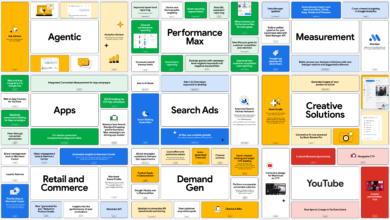PPC 2026: AI, Automation, and the Battle for Clicks

▼ Summary
– PPC platforms are increasingly shifting toward AI-first campaign formats like Performance Max, reducing manual controls and transparency for advertisers.
– Industry professionals report that AI tools save time on tasks like keyword research but still require significant human oversight due to inconsistent output quality.
– Control in PPC now focuses on setting clear business objectives and providing high-quality conversion data rather than managing granular campaign details.
– Measurement strategies are evolving to prioritize reliable metrics like revenue over perfect attribution, with an emphasis on first-party data collection.
– AI-generated creative assets can perform competitively with human-made versions when prompted effectively, though human oversight remains crucial for brand voice and compliance.
Navigating the evolving world of PPC advertising requires a clear-eyed view of how artificial intelligence and automation are reshaping campaign management. Platforms are increasingly steering decisions, with once-familiar controls fading into the background. Campaign types like Performance Max and Demand Gen now dominate, often set as the default. This shift means AI now crafts ad copy and selects audiences using signals that aren’t always transparent. When performance dips, advertisers find themselves with fewer direct levers to pull and less insight into the underlying causes. While this transition can feel unsettling, it isn’t reversing, so adapting strategically has become essential.
We spoke with a range of PPC professionals to understand how they are handling this transformation. Rather than expressing pessimism, many have discovered practical methods to collaborate with platform automation while preserving the strategic oversight that drives meaningful outcomes. You can leverage AI tools without sacrificing your expertise in the process.
Here are four key insights from our industry survey.
1. AI Tools Save Time But Still Need Babysitting
Most professionals now incorporate AI into their daily routines for activities like keyword research and generating ad copy variations. These tools have matured enough to become integral to standard workflows.
However, a significant limitation remains. Over half of those surveyed pointed to inaccurate, unreliable, or inconsistent output quality as the primary drawback. While AI speeds up production, it hasn’t eliminated the necessity for human supervision. One contributor highlighted that in regulated sectors requiring legal review, AI-generated content often needs substantial revision before it can be used. The most effective practitioners treat AI as a capable assistant, not a replacement for their judgment.
2. “Control” Means Something Different Now
The days of micromanaging exact search terms or setting precise bids on individual keywords are fading. Rigid campaign parameters are increasingly a thing of the past.
Several experts argue that meaningful control still exists, it just functions differently. One Google Ads coach likened it to giving a teenager a destination address and trusting they will find their way, even if they take a detour or two. The new version of control involves setting clear business objectives and supplying high-quality conversion data. If your conversion tracking is messy or incomplete, the AI will optimize toward misguided goals, undermining your efforts.
3. Measurement Got More Honest (And More Uncomfortable)
Although cookie deprecation in Chrome was postponed, measurement difficulties have not vanished. What has shifted is how practitioners discuss attribution.
One agency founder confessed that obsessing over perfect attribution may have been a strategic error. “Your marketing strategy should remain robust even if granular tracking disappears,” they noted. Other contributors stressed that collecting first-party data with proper consent is now vital, especially for lead generation models. When platform-reported metrics conflict, revenue stands out as the most dependable source of truth. A durable measurement strategy involves selecting a limited set of reliable indicators rather than trying to reconcile every available data stream.
4. Platform-Generated Creative Performs Better Than You’d Think
This finding often comes as a surprise. Several contributors reported that AI-generated creative assets can compete effectively with human-made versions, when they are prompted skillfully.
The phrase “when prompted skillfully” carries significant weight here. Output quality depends heavily on how well you instruct the tools and how much brand context you supply. These systems still face challenges in maintaining a consistent brand voice and meeting legal standards in regulated fields. Visual generation, particularly for ecommerce product photography, is improving but still needs refinement. Most teams have adopted a hybrid approach: AI handles idea generation and creates variations, while humans oversee final approval and anything demanding nuanced brand expression.
What Makes This Report Different
Earlier reports often concentrated on specific platform updates or new features. This year, we delved into broader strategic questions. How do you maintain visibility when platforms reduce transparency? Which measurement techniques remain effective when attribution is unclear? How should creative workflows evolve when AI can produce assets on demand?
Contributors to this report include professionals from various backgrounds, including agency co-founders, product liaisons, and directors of search and media strategy. Their responses illustrate an industry adapting in real time. Some have fully embraced AI-first workflows, while others proceed cautiously, wary of relinquishing too much control. All are continuously experimenting because the platforms themselves show no signs of slowing their evolution.
Why Download This Now
If you are managing campaigns, you are likely grappling with these very issues. Are you tackling them with a coherent strategy, or simply reacting to each platform update as it occurs?
This report reveals how seasoned professionals at agencies, platforms, and consultancies are reasoning through the same problems you face today. Download our PPC Trends 2026 report to see how industry experts are refining their strategies, preserving accountability in automated campaigns, and discovering methods to make AI-first advertising effective without losing the strategic insight that separates outstanding campaigns from average ones.
(Source: Search Engine Journal)





